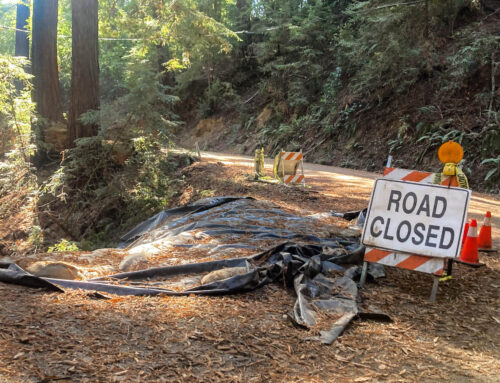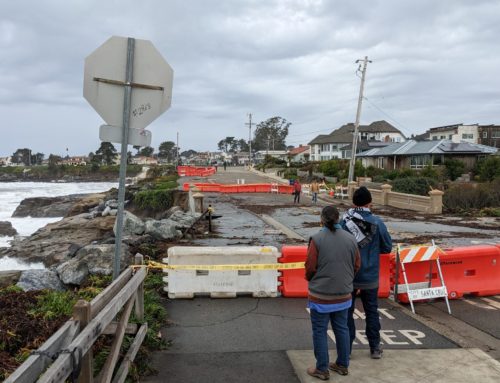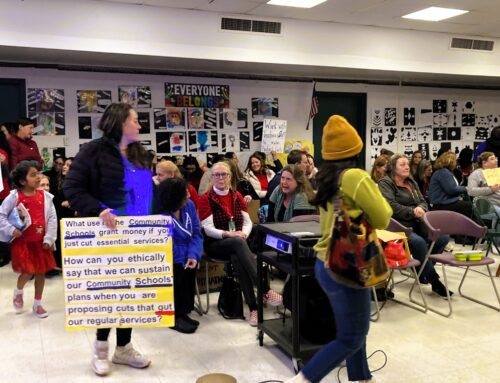Read Santa Cruz Local's Election Guide
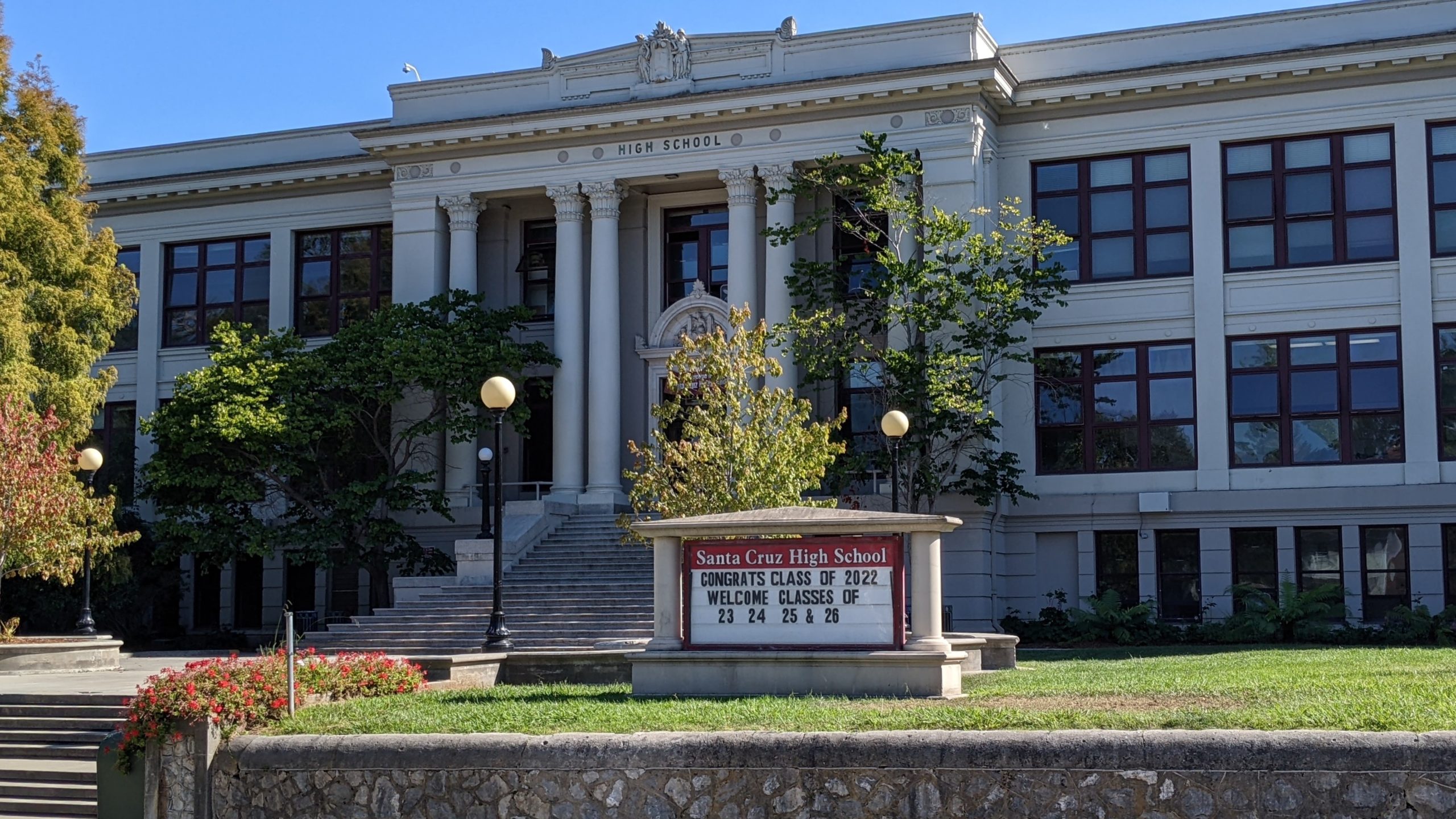
Measure K in the Nov. 8 election would provide money for upgrades at schools such as Santa Cruz High School. (Stephen Baxter — Santa Cruz Local)
What are Measures K and L?
Measures K and L would raise money to repair, modernize and construct new buildings at 10 Santa Cruz City Schools sites. Voters in Santa Cruz City Schools boundaries will decide the measures. The measures each require more than 55% of the vote for approval.
What would Measures K and L do?
Measures K and L would raise taxes on homeowners and allow the school district to issue $371 million in bonds. Measure L would benefit Santa Cruz City Schools’ elementary district. Measure K would provide money for the middle, high and alternative school district. About 5% of the bond money also would pay for 80 units of housing for employees of Santa Cruz City Schools, school district leaders said.
What does a “yes” vote mean?
A “yes” vote on Measure L would provide $122 million for building upgrades that serve about 1,731 students in Santa Cruz City Schools’ elementary district.
A “yes” vote on Measure K would provide $249 million for building upgrades that serve roughly 4,407 students in Santa Cruz City Schools’ middle, high and alternative school district.
- If Measures L and K are adopted, a typical homeowner in the elementary school district would pay $360 annually, said Sam Rolens, a spokesman for Santa Cruz City Schools.
- If Measures L and K are adopted, a typical homeowner who is only in the middle and high school district but not in the elementary school district would pay $180 annually. All homeowners in the elementary school boundaries are also in the middle and high school boundaries, Rolens said.
- If only Measure K is adopted, a typical homeowner in Santa Cruz City Schools’ middle, high and alternative school district would pay $180 annually, Rolens said.
What does a “no” vote mean?
A “no” vote would not raise taxes and not repair and construct new buildings at Santa Cruz City Schools.
Things to consider
Throughout the state, public school districts put bond measures on local ballots to help pay for construction, repairs and infrastructure updates with local money.
“The main thing that we’d like the public to know is that we don’t get any substantial regular funding for building or repairing anything on our campuses. It’s just not part of the school funding that we’re getting from the state and the federal government,” said Sam Rolens, a spokesman for Santa Cruz City Schools. “We do have some money set aside for basic repairs, but it’s just not enough,” Rolens said.
Measures L and K come on the heels of a pair of bonds for Santa Cruz City Schools that voters approved in 2016. Voters approved bonds before then in 1998. Measures A and B issued $140 million and $68 million in bonds for Santa Cruz City Schools campus improvements.
“What we were able to do with the first round of bonds is modernize about 50% of our campuses,” said Santa Cruz City Schools Superintendent Kris Munro. “It’s about finishing the roofing, finishing the (heating, ventilation and air conditioning) — it’s so important,” Munro said.
Banks would sell the bonds, provide money to the school districts and collect the money back from homeowners. The collection would start in July 2023 and end in 2054, according to a school district statement.
The bond proposal comes nearly six years after voters approved Santa Cruz City Schools’ bond Measures A and B in 2016. Voters approved Measure A with 75.8% of the vote and Measure B with 79.5% of the vote.
Measures A and B secured $208 million toward updates and construction of new school facilities. Dozens of projects have been completed, from card access security systems in classrooms to parking lots to information technology upgrades, according to a recent audit.
Some other projects have included:
- Upgraded airflow and filtration in classrooms.
- Connecting all schools to high-speed internet and Wi-Fi.
- Construction of a library at Soquel High School.
- Construction of a gym at Santa Cruz High School.
During the pandemic and distance learning in 2020 and 2021, school leaders updated some infrastructure with 2016 bond money. Those projects included repairs to electric grids, water stewardship, internet, plumbing and heating, ventilation and air conditioning. Also during the pandemic, the 2016 bonds funded new classrooms, a library and an outdoor gym and field.
If voters adopt Measures L and K in the Nov. 8 election, some campuses could become more energy efficient. Munro said advanced sustainability plans would make water use more efficient and save energy with new double-pane windows.
“One school, Bay View Elementary, will likely be a net zero-energy campus within the next two years,” Rolens said. “With a small influx of bond funding, we could really increase efficiency in all of our campuses, and also install a lot of solar panels and a lot of places that we have determined so that we can bring ourselves toward net zero districtwide.”
With about $19 million — or about 5% of the bond money from Measure L and K — the district plans to build 80 units of below-market rate workforce housing rentals on the Westside, behind the former site of Natural Bridges Elementary School. That proposed development, which has been in discussion during the past six years, could help with “alleviating the housing crisis that’s going on in Santa Cruz,” said Rolens.
Munro said that, according to her discussions with staff, the system has lost 96 teachers, or about 25% of the current teacher workforce, since 2014 due to the area’s high cost of living.
The cost and lack of housing availability has helped repel potential new teachers from working in the district, leaders of Santa Cruz City Schools said. About 95% of teachers who received job offers declined those offers due to the inability of available and affordable housing, according to follow-up conversations.
More information
- Measure K text
- Measure L text
- Arguments for and against Measure K published by the Santa Cruz County Clerk
- Arguments for and against Measure L published by the Santa Cruz County Clerk
- Register to vote in Santa Cruz
Editor’s note: Below is the original Santa Cruz Local story on the school bond measures, published Aug. 19.
Voters to decide bonds for Santa Cruz City Schools
By Grace Stetson
Aug. 19, 2022
SANTA CRUZ >> Voters in November will decide whether Santa Cruz City Schools should issue about $371 million in bonds to fund school upgrades. The bonds would raise taxes on homeowners in the school district.
Measure L would benefit Santa Cruz City Schools’ elementary district. Measure K would provide money for the middle, high and alternative school district. Both bond measures are needed to repair, modernize and construct new buildings at the two districts’ 10 schools, said Santa Cruz City Schools Superintendent Kris Munro.
“Our campuses are having all kinds of problems — the youngest ones are more than 50 years old, and the oldest ones are over 100 years old,” Munro said.
About 5% of the bond money also would pay for 80 units of housing for employees of Santa Cruz City Schools, school district leaders said.
The measures require more than 55% of the vote for approval. Throughout the state, public school districts put bond measures on local ballots to help pay for construction, repairs and infrastructure updates with local money.
“The main thing that we’d like the public to know is that we don’t get any substantial regular funding for building or repairing anything on our campuses. It’s just not part of the school funding that we’re getting from the state and the federal government,” said Sam Rolens, a spokesman for Santa Cruz City Schools. “We do have some money set aside for basic repairs, but it’s just not enough,” Rolens said.
Measures L and K come on the heels of a pair of bonds for Santa Cruz City Schools that voters approved in 2016. Voters approved bonds before then in 1998. Measures A and B issued $140 million and $68 million in bonds for Santa Cruz City Schools campus improvements.
“What we were able to do with the first round of bonds is modernize about 50% of our campuses,” Munro said. “It’s about finishing the roofing, finishing the (heating, ventilation and air conditioning) — it’s so important,” Munro said.
What are the bonds?
Voters in Santa Cruz City Schools boundaries will decide the measures. Leaders from Santa Cruz City Schools oversee two districts — an elementary district, and a separate district for middle, high and alternative schools.
Voters in both districts will see both measures on the ballot.
Santa Cruz City Schools’ 10 schools include:
- 6,200 students.
- 420 teachers.
- 337 support staff, inside and outside the classroom.
- 41 administrators.
Measure L for the elementary district would provide $122 million for building upgrades that serve about 1,731 students.
Measure K for the middle, high and alternative school district would provide $249 million for building upgrades that serve roughly 4,407 students.
If Measures L and K are adopted, a typical homeowner in the elementary school district would pay $360 annually, Rolens said. If Measures L and K are adopted, a typical homeowner who is only in the middle and high school district but not in the elementary school district would pay $180 annually.
All homeowners in the elementary school boundaries are also in the middle and high school boundaries, Rolens said. If only Measure K is adopted, it’s not yet clear how much a typical homeowner would pay because the district’s financial analysis is not complete, Rolens said.
Only homeowners in the Santa Cruz City Schools districts will vote on the measures and pay for them if they pass.
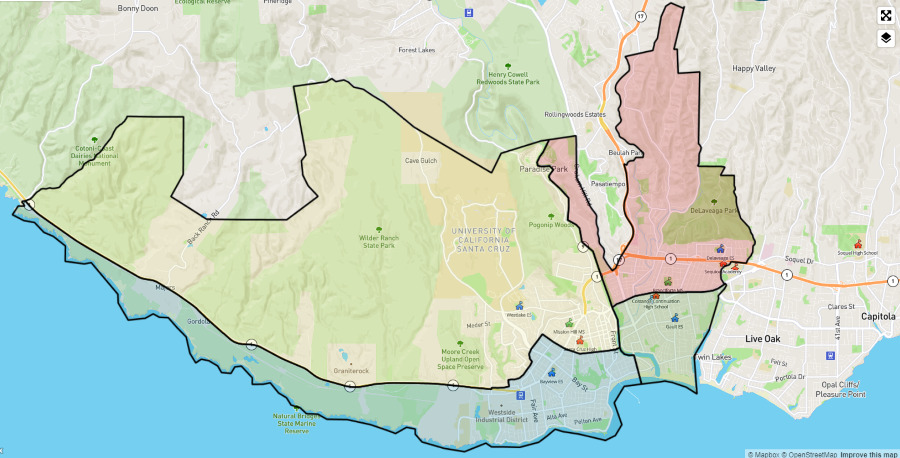
Elementary school boundaries of Santa Cruz City Schools. (Santa Cruz City Schools)
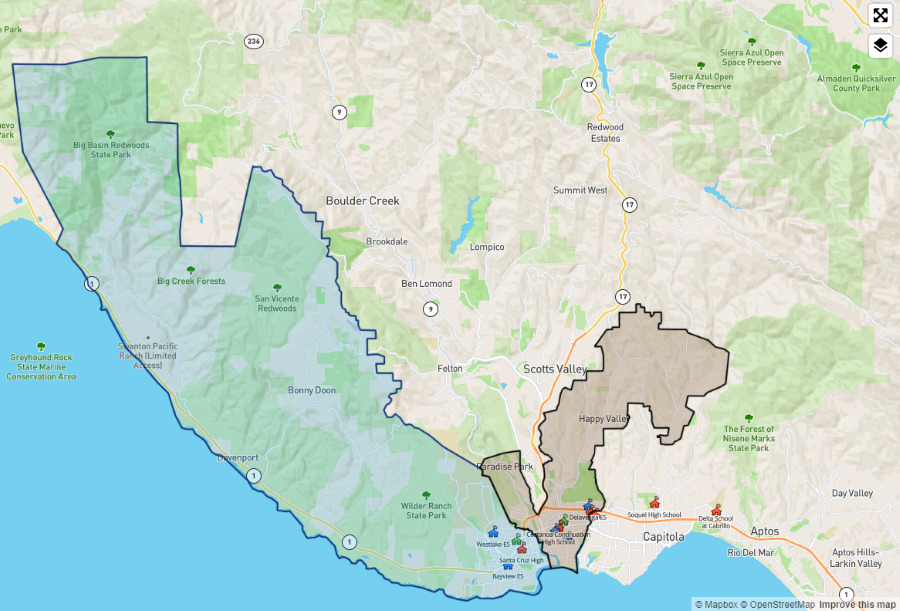
Middle school boundaries of Santa Cruz City Schools. (Santa Cruz City Schools)
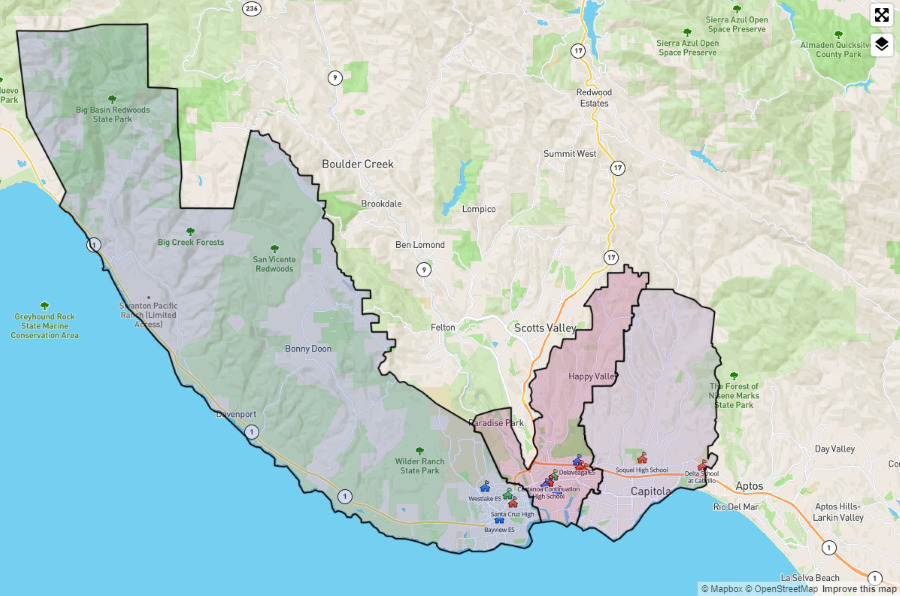
High school boundaries of Santa Cruz City Schools. (Santa Cruz City Schools)
Banks would sell the bonds, provide money to the school districts and collect the money back from homeowners. The collection would start in July 2023 and end in 2054, according to a school district statement.
The bond proposal comes nearly six years after voters approved Santa Cruz City Schools’ bond Measures A and B in 2016. Voters approved Measure A with 75.8% of the vote and Measure B with 79.5% of the vote.
What the 2016 bonds funded
Measures A and B secured $208 million toward updates and construction of new school facilities. Dozens of projects have been completed, from card access security systems in classrooms to parking lots to information technology upgrades, according to a recent audit.
Some other projects have included:
- Upgraded airflow and filtration in classrooms.
- Connecting all schools to high-speed internet and Wi-Fi.
- Construction of a library at Soquel High School.
- Construction of a gym at Santa Cruz High School.
During the pandemic and distance learning in 2020 and 2021, school leaders updated some infrastructure with 2016 bond money. Those projects included repairs to electric grids, water stewardship, internet, plumbing and heating, ventilation and air conditioning. Also during the pandemic, the 2016 bonds funded new classrooms, a library and an outdoor gym and field.
There is still a great deal left to be done, Munro said. Munro and Rolens said money from Measures A and B covered about half of the upgrades and renovations that the schools need. Many projects remain planned and have committed money. About $15 million is expected to remain from Measures A and B by 2024, which is not enough to finalize school needs, district leaders said in May.
The Santa Cruz City Schools’ proposed master plan in June showed a $441.4 million list of prospective projects across the 10 schools.
Measures L and K
If voters adopt Measures L and K in the Nov. 8 election, some campuses could become more energy efficient. Munro said advanced sustainability plans would make water use more efficient and save energy with new double-pane windows.
“One school, Bay View Elementary, will likely be a net zero-energy campus within the next two years,” Rolens said. “With a small influx of bond funding, we could really increase efficiency in all of our campuses, and also install a lot of solar panels and a lot of places that we have determined so that we can bring ourselves toward net zero districtwide.”
With about $19 million — or about 5% of the bond money from Measure L and K — the district plans to build 80 units of below-market rate workforce housing rentals on the Westside, behind the former site of Natural Bridges Elementary School. That proposed development, which has been in discussion during the past six years, could help with “alleviating the housing crisis that’s going on in Santa Cruz,” said Rolens.
Munro said that, according to her discussions with staff, the system has lost 96 teachers, or about 25% of the current teacher workforce, since 2014 due to the area’s high cost of living.
The cost and lack of housing availability has helped repel potential new teachers from working in the district, leaders of Santa Cruz City Schools said. About 95% of teachers who received job offers declined those offers due to the inability of available and affordable housing, according to follow-up conversations.
“In the eight years I’ve been superintendent, we’ve seen the turnover,” Munro said. “They want to get settled, and they can’t do it here.”
Opposition and support
Munro and Rolens said they were not aware of organized opposition to the bond measures, perhaps due to a shift in the conversation.
“I think, just really my own personal hope, is that we’re getting to the point where there’s going to be a greater agreement of needing to invest in these updates looking forward,” Rolens said.
With the potential benefits of this bond funding, Rolens and Munro said all students — let alone the teachers, support staff, administrative staff and community at large — will see the long-term benefit.
“We’re making sure that we’re offering the highest quality education for the students in the district,” Rolens said.
Arguments for and against the ballot measures are due to the Santa Cruz County Clerk by 5 p.m. Friday Aug. 19.
Editor’s note: This story has been udpated with additional tax payment information and district maps.
Questions or comments? Email [email protected]. Santa Cruz Local is funded by members, major donors, sponsors and grants for the general support of our newsroom. Our news judgments are made independently and not on the basis of donor support. Learn more about Santa Cruz Local and how it is funded.
Santa Cruz Local’s news is free. We believe that high-quality local news is crucial to democracy. We depend on locals like you to make a meaningful contribution so everyone can access our news. Learn about membership.
Grace Stetson is a Santa Cruz County freelance journalist who covers housing, homelessness and development. Stetson is a graduate of the Medill School of Journalism master's program. Stetson has worked for Dateline NBC, Walt Disney Publishing Worldwide, Metro Silicon Valley, the Six Fifty, Good Times and Lookout Santa Cruz.
Stephen Baxter is a co-founder and editor of Santa Cruz Local. He covers Santa Cruz County government.



